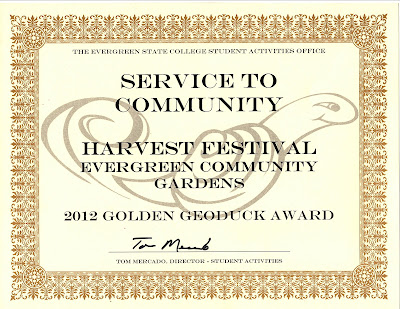Click on any image for a larger view
The Student Organized Agricultural Project (S.O.A.P.) is a GO! for 2015!
The amazing Hannah S. and Jackie V. are this year's student facilitators, along with Community Garden Coordinators Gabrielle and Colin.
If you want to be part of a gardening team
to take something like this...
to take something like this...
 |
| the garden in the rough, early spring |
and transform it into something like this...
 |
| the garden in mid-June as crops start coming in |
...then you should consider joining the S.O.A.P. team plot!
A Part of the Evergreen Community Garden Club,
a Registered Student Organization
tesccommunitygardens@gmail.com
https://www.facebook.com/ecogardens
 We have a HUGE plot in Evergreen Community
Gardens dedicated to
people who do not want an individual plot, but still want to get their hands
dirty at Evergreen’s garden. It works great for anyone who thinks they might be
gone for part of the summer, isn’t sure they want their own plot, can commit
some time, but aren’t sure how much, and people who just like the idea of
working on a team in a larger plot, with more crop options. Originally proposed by graduate student and gardener,
We have a HUGE plot in Evergreen Community
Gardens dedicated to
people who do not want an individual plot, but still want to get their hands
dirty at Evergreen’s garden. It works great for anyone who thinks they might be
gone for part of the summer, isn’t sure they want their own plot, can commit
some time, but aren’t sure how much, and people who just like the idea of
working on a team in a larger plot, with more crop options. Originally proposed by graduate student and gardener,Matthew, the project is loosely modeled after
the Wendell Berry Community Garden
in east Olympia
 |
| Pollinators have a happy home here |
Every year is a lot of fun. Last year we started with around 20 gardeners. A few moved out of the area and we ended up with way more of some food than we could use. Some things do really well, and some things kind of flop, so we learn as we go. Every season is different and there are no “experts”.
 From harvest to juicing and smoothies. We usually have more than enough food for the team gardeners!
From harvest to juicing and smoothies. We usually have more than enough food for the team gardeners! 
 |
| Team gardener and former Masters of Environmental Studies student, Kim J. in our bean trellis |
Crop planning happens as a group. It is already underway for the 2015 season.
The basic plan behind the project:
- 10 to 20 gardeners
- Regularly scheduled meetings especially during the planning and work party stages, but come and go as you please.
- Everyone who participates shares in the harvest
 |
| Most beloved of all farm managers, Rose, holding one of many harvest baskets |
Here
is a general list of gardeny things we can do:
- Get together and create our crop plan
- Go through seed catalogs
- Decide what we want to plant (so we can get seeds) and where we want to plant them (crop rotation from last year)
- Draw a plan on garden map
- Make a “To Do” check list to help guide gardeners who come at different times
- Tool familiarization
 |
| S.O.A.P. team starting seeds in the beautifully expanded greenhouse, 2013 season |
- Start seeds in the greenhouse (can start now, on-going through the season)
- Some good things to start now are hearty greens (kale, collards etc), onions, etc.
- Working the soil – creating seed beds
- Clear out old beds
- Dig and/or double dig
- Add soil amendments (compost, etc.)
- Let rest for a week or so, then
- Plant our starts
- Garden Feng Shui
 |
| 2012 team clowning at first work party of the season |
- Creative use of space
- Thinning
- Vertical gardening
- Shape of the beds
- Ornamental/Insectary borders (flowers and herbs)
- Culinary herb patch
- What herbs do we want to grow
- Tending and maintenance
- Watering
- Weeding
- Pruning
- Snacking
- Harvesting
- Garden
- Potlucks
- Helping with Community Garden upkeep
- Doing our part for the larger garden
- Pitching ideas/helping out with Harvest Festival
 |
| Harvest Basket we put together for Student Activities, 2014 |
The S.O.A.P. garden group is forming now. There is still time to sign up. The first step is to
put together an Interest List.
All interested people should contact garden coordinators at tesccommunitygardens@gmail.com and they will compile a list of people interested in the Community Plot, or contact Hannah. We will be having on-going planning meetings and hope to have a work party in mid-April in preparation for April and May plantings.
 | ||
| Meditation nook, 2012 |
 |
| Divvying up a cucumber harvest |
 |
| 5 yards of compost, 2014. |
(For the record, over 100 wheel barrow loads. It is work but it is fun!)















